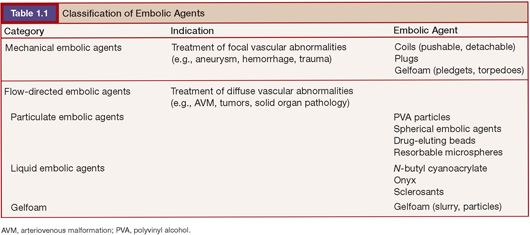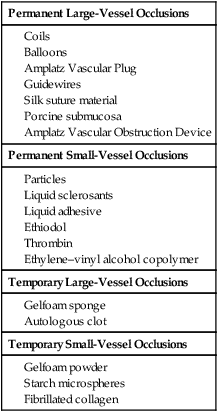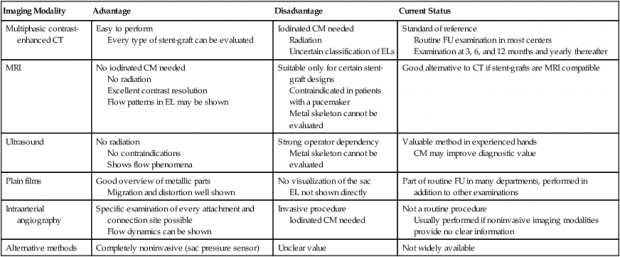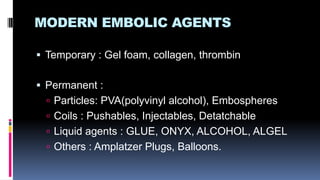Embolization Agents Which One Should Be Used When Part 2
How I Do It. Embolization AgentsWhich One Should Be Used When.

Brief History And Classification Of Embolic Agents Radiology Key
Gelfoam is a fast cheap and reliable embolic agent.
. 2 rows Embolization agents-which one should be used when. Gelatin sponge Gelfoam Pharmacia Upjohn the most widely used temporary embolic agent is an absorbable bioprosthetic material available as a block sponge or sheet or as a powder. 1 Since that time Gelfoam has evolved into a common agent used for a variety of applications.
Gelatin foam Gelfoam Upjohn Kalamazoo MI has been used as an intravascular embolization agent for more than 30 years with the first intravascular use in 1964 for cavernous carotid fistulas. Review Free to read. Blocking the part of the.
Warfarin to achieve target INR of 25 range. The Content and Format of. In this situation only one embolization code should be assignedcode 37243 for the tumor embolization.
Semin Intervent Radiol 27199-104 01 Mar 2010 Cited by. Cited by in Crossref. The skin layer involved in the flap.
Lubarsky M Ray CE Funaki B. Gelfoam comes as a layer of foam that should be cut into small pieces and then mixed with contrast solution to create a very thick mixture slurry that can be used for embolization. Embolization agents-which one should be used when.
Georg Thieme Verlag KG. By Michael Lubarsky Charles Ray and Brian Funaki. 5 During that time the indications expanded into the treatment of gastroesophageal.
The liver is special in that it has 2 blood supplies. Use of Gelfoam is off-label for embolization but its use is within. It can help stop heavy bleeding hemorrhage or prevent an aneurysm from rupturing.
The following embolic agents were used. 20 to 30 or aspirin 325 mg per day Patient age 65 to 75 years More than one risk factor. The most superficial layer in the flap.
In the early 1970s experience with peripheral embolization was initially gained as a treatment option for acute gastrointestinal bleeding. 3 used 3-mm stainless steel pellets for embolization and Newton and Adams 4 used lead pellets and small fragments of muscle. This stops blood from flowing to the area.
Embolization is a minimally invasive treatment that blocks one or more blood vessels or abnormal vascular channels. The novel liquid embolic agents have not been adequately evaluated and most embolization treatments were observed for no more than 2 weeks. Embolization agents-which one should be used when.
45 Cited by in F6Publishing. Principles and Clinical Applications. In a catheter embolization procedure medications or synthetic materials called embolic agents are placed through a catheter into a blood vessel to prevent blood flow to the area.
An abnormal connection between arteries can be removed. Subcutaneous tissuefascia and muscle body parts the body part value represents. It is not appropriate to also assign code 37242 for the embolization of the at-risk vessels since they are part of the same surgical field.
All of the layers involved in the flap. By Michael Lubarsky Charles Ray and Brian Funaki. Embolization is a procedure to create a clot or block in a blood vessel.
Most normal liver cells are fed by the portal vein whereas a cancer in the liver is mainly fed by the hepatic artery. Embolization AgentsWhich One Should Be Used When. However catheterization of these vessels should be coded separately.
Gel-foam powder particles range from 10 to 100 μ. In Transfer procedures that involve more than one layer such as the. In long-term clinical use commercial liquid embolic agents have been optimized in composition ratio administration method and clinical scenarios so they are gradually being favored by clinicians.
Microcoils n 16 polyvinyl alcohol PVA particles n 2 and a combination of microcoils and PVA particles n 2. Please use the document number 1234 to identify the guidance you are requesting. Hence one of the most difficult decisions an operator must make before any given embolization procedure is what embolic agent to use.
The deepest tissue layer in the flap. Semin Intervent Radiol 27199104. The field of embolization therapy has grown immensely in the past 2 decades as the role of devascularization as well as the technologies available to do so have substantially increased.
24 articles PMID. The procedure may be used to treat many conditions. Gelfoam provides vessel occlusion typically lasting 36 weeks.
Lubarsky M Ray C Funaki B 2010 Embolization agents-which one should be used when. A systematic approach can be used to determine the best agent for most clinical scenarios encountered. Lubarsky M Ray C Funaki B.
Embolization is a procedure that injects substances directly into an artery in the liver to block or reduce the blood flow to a tumor in the liver. Cited in This Article. Embolization agents-which one should be used when.
Doppman et al. Article Google Scholar Lubarsky M Ray CE Funaki B 2009 Embolization agents-which one should be used when. Embolization Therapy is among the first of interventional radiology books to focus its attention.
One risk factor.

Embolization Agents Radiology Key

Polymeric Materials For Embolic And Chemoembolic Applications Abstract Europe Pmc

Embolic Agents Used For Congenital Avm Embolization Download Table

Pdf Embolization Agents Which One Should Be Used When Part 2 Small Vessel Embolization

Commonly Used Embolic Materials And Characteristics Download Table

Liquid Embolic Agents And Immediate And Follow Up Outcomes Download Scientific Diagram

Embolization Agents Radiology Key

Liquid Embolic Agents And Immediate And Follow Up Outcomes Download Scientific Diagram

Pdf Embolization Agents Which One Should Be Used When Part 2 Small Vessel Embolization

Brief History And Classification Of Embolic Agents Embolic Materials Embolization Therapy Principles And Clinical Applications 1 Ed

Endovascular Treatment Of Intra And Extra Cranial Malformation Ppt Download
Divisions Of Embolic Agents Pva Polyvinyl Alcohol Ggvod Download Scientific Diagram
Embolization Materials Technique Angiofellow Com
Embolization Materials Technique Angiofellow Com

Vascular And Solid Organ Trauma Interventional Radiology Ppt Download

Beyond Saving Lives Current Perspectives Of Interventional Radiology In Trauma
